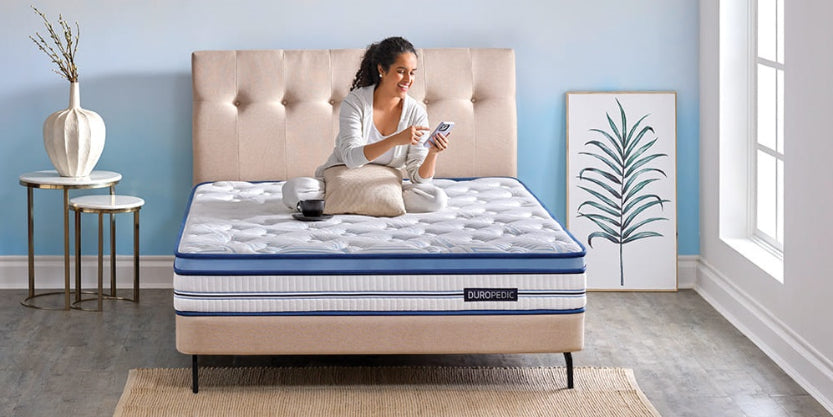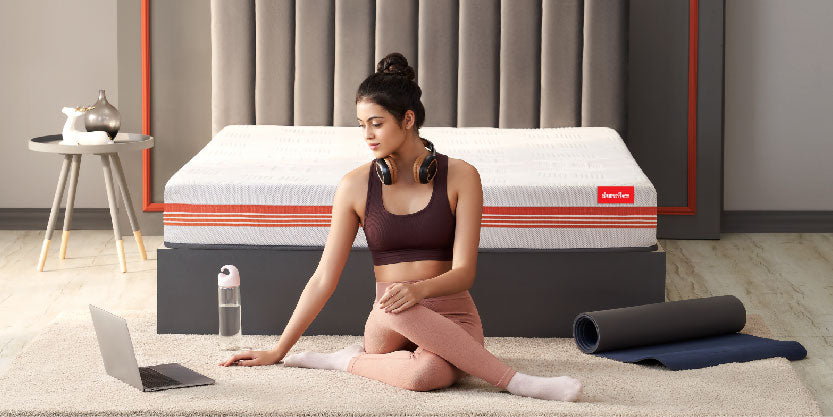Back pain is a modern epidemic. Whether caused by sedentary lifestyles, bad posture, stress, or lack of physical activity, millions of people around the world struggle with persistent back issues. It affects people across age groups, professions, and routines—making it one of the most common health complaints globally. Unfortunately, many sufferers focus solely on temporary relief methods such as massages, heating pads, and painkillers, without considering one of the most crucial elements of long-term recovery: the mattress they sleep on every night.
The truth is, your sleep environment, especially your mattress, can play a far bigger role in either healing or aggravating back pain. The wrong mattress can silently contribute to spinal misalignment, muscle tension, and poor sleep quality. On the other hand, the right one can support your natural posture, promote relaxation, and facilitate deep, restorative rest.
If you've ever woken up feeling stiff, sore, or more fatigued than when you went to bed, your mattress could be the culprit. The quality and design of your mattress directly affect how well your back is supported throughout the night. Let’s explore the science behind spinal alignment, how your mattress plays a vital role in pain prevention and recovery, and how to choose the best orthopedic mattress that supports your back—night after night.
Understanding the Connection Between Mattresses and Back Pain
When your spine is not properly supported during sleep, the muscles surrounding it must work overtime to keep it aligned. Instead of relaxing during rest, these muscles remain engaged throughout the night, leading to fatigue, stiffness, and potential inflammation. Over time, this strain can result in chronic pain, poor sleep quality, and even long-term postural issues such as a curved spine or misaligned hips. That’s where choosing the right mattress for back pain becomes crucial—it can either correct these imbalances or exacerbate them.
Your mattress should ideally keep your spine in a neutral position—neither overarched nor unnaturally flat. This alignment allows the vertebrae to rest in their natural curvature, ensuring that no area of the back is under excessive stress. A sagging or unsupportive mattress can disrupt this equilibrium, putting pressure on sensitive areas such as the lumbar spine, hips, and shoulders. Over time, this leads to pain that lingers throughout the day, affecting your mobility and energy levels. This is why finding the firm mattress for back pain that supports your body type and sleeping position is so important—it provides the foundation for restful, healing sleep that restores your spine night after night.
Mattress for Back Pain: Choosing the Right Support
When looking for the right mattress for back pain, firmness and material are key considerations. The goal is to balance comfort with spinal alignment, providing relief from pressure points without sacrificing support. A mattress that lacks adequate support can throw your entire spine out of alignment, leading to muscular tension, poor circulation, and sleepless nights. Likewise, a surface that's too rigid can cause pain in areas like the shoulders and hips, especially for side sleepers. The right choice blends cushioning and resilience in just the right measure.
There are several options, but a firm mattress for back pain often works best for people with lower back issues. It provides the resistance needed to prevent your hips and lower back from sinking too deeply into the surface. This helps maintain the natural curve of the spine, ensuring the body stays evenly supported throughout the night. However, firmness alone isn’t enough—the mattress should also offer targeted support zones and contouring materials that respond to your unique body shape. Zoned mattresses, for instance, may offer firmer support at the lumbar region and softer zones around the shoulders and legs for balanced weight distribution.
Orthopedic mattresses are designed specifically to alleviate pressure and maintain posture during sleep. A best orthopedic mattress not only supports the back but also distributes body weight evenly, reducing tension on the spine and joints. Whether you sleep on your back, side, or stomach, this can significantly reduce discomfort and improve your quality of sleep. Modern orthopedic designs also incorporate breathable materials and anti-sagging layers, ensuring durability and consistent performance over time—making them an excellent investment in long-term health and sleep wellness.
Firm Mattress for Back Pain: Too Firm or Just Right?
While it’s widely believed that firmer mattresses are better for back pain, the level of firmness must be tailored to the individual. Each person’s back pain is unique, and the effectiveness of a mattress often hinges on how well it conforms to specific pressure zones. A mattress that's too hard can create pressure points around the shoulders and hips, especially for side sleepers, which can exacerbate discomfort and lead to restless nights. On the other hand, a mattress that's too soft can allow the body to sink in excessively, leading to misalignment of the spine and unnecessary strain on the lower back muscles.
This is where medium-firm options come into play. A firm mattress for back pain with adequate cushioning offers a balanced sleeping surface that maintains spinal neutrality while cushioning joints. These mattresses are designed to support the natural S-curve of the spine, ensuring that no area is overcompensated or left unsupported. The right firmness level also varies by body weight. Heavier individuals generally benefit from firmer surfaces that resist deep sinkage, while lighter sleepers may find better comfort with a slightly softer yet supportive mattress that still encourages proper alignment.
Remember, comfort and support aren’t mutually exclusive. Some of the best orthopedic mattress options strike a perfect balance by combining firm core layers with softer comfort layers—offering structured support without compromising on plushness. These multi-layered constructions cater to a variety of sleeping styles and health needs, making them a reliable choice for those seeking to ease or prevent back pain.
Memory Foam vs Latex Mattress: Which is Better for Back Pain?
One of the most common dilemmas buyers face is choosing between memory foam vs latex mattress. Both have unique properties that make them suitable for different types of sleepers, especially those suffering from back pain. Making the right decision here can significantly impact how well your mattress performs in relieving pressure, promoting spinal alignment, and maintaining durability over time.
Memory Foam:
-
Molds to the shape of your body, offering customized pressure relief by adapting to your curves
-
Ideal for relieving joint pain and pressure point discomfort, especially for side sleepers
-
Excellent motion isolation for couples, which means you’re less likely to be disturbed by a partner’s movements
-
Can retain heat, so not ideal for hot sleepers unless infused with cooling gel or enhanced with airflow channels
Memory foam is particularly appreciated by people who prefer a soft, enveloping feel. It cradles the body in a way that promotes even weight distribution and minimizes tossing and turning. However, it may not be ideal for those who frequently change sleeping positions or prefer a more buoyant surface.
Latex Foam:
-
Naturally resilient and bouncier than memory foam, making it easier to shift positions
-
Offers more responsiveness and ease of movement, which is great for combination sleepers
-
Naturally cooling and hypoallergenic, ideal for people with allergies or sensitive skin
-
Typically more durable and eco-friendly, especially if made from organic or natural latex
Latex is well-suited for sleepers who enjoy a firmer, more lifted feel. Its inherent bounce provides quick recovery and resists permanent body impressions, making it a durable long-term option. It’s also a great choice for hot sleepers due to its naturally breathable structure.
When comparing memory foam vs latex mattress, it comes down to personal preference and sleep style. For people who prefer a contouring feel and don’t move much during sleep, memory foam may be the better choice. For those who like a firmer, springier feel with better breathability, latex is often preferred. Both offer significant benefits for managing back pain, depending on how your body interacts with the surface and how much support you require.
Many of the best orthopedic mattress options today combine layers of both memory foam and latex, providing the best of both worlds—adaptive support and natural resilience. These hybrid models are designed to maximize comfort while ensuring long-term spinal health, making them an ideal choice for those who don’t want to compromise on either softness or firmness.
Sleeping Positions for Back Pain: Does It Matter?
Your sleeping posture has a direct impact on back health. Whether you’re a side sleeper, back sleeper, or stomach sleeper, choosing the right sleeping positions for back pain and pairing them with an appropriate mattress can reduce morning stiffness and long-term pain. It's not just about the position you fall asleep in, but also how your body is supported throughout the night.
Back Sleepers: Need support for the natural curve of the lower back. A medium-firm mattress works well here, providing enough give to accommodate the spine’s gentle arch while offering the firmness needed to prevent lower back sagging. Adding a small pillow under the knees can also help keep the spine in alignment, especially for those dealing with lumbar discomfort.
Side Sleepers: Require contouring around the hips and shoulders. A mattress that cushions pressure points while supporting spinal alignment is ideal, as it allows the spine to remain straight while cradling the body's curves. Choosing a mattress with memory foam or zoned support can help reduce tension in the neck, shoulders, and lower back. Using a thicker pillow between the head and shoulder can also prevent neck misalignment.
Stomach Sleepers: Should avoid overly soft surfaces that allow the abdomen to sink, placing strain on the lower back. A firm mattress for back pain is often recommended to keep the torso elevated and reduce spinal curvature. Placing a thin pillow under the pelvis can also help neutralize the spine's position and minimize pressure on the lumbar region.
Each of these sleeping positions for back pain interacts with the mattress differently, making it essential to choose one tailored to your sleep habits. Your sleep posture determines how your spine, neck, and joints are aligned over several hours of rest. A mattress that complements your posture will support spinal alignment and relieve tension throughout the night, leading to more restorative and pain-free sleep.
The Importance of Trying Before Buying
Mattress comfort is subjective. What feels great to one person may be unsuitable for another. That’s why many brands now offer sleep trials, which have become an essential part of the mattress-buying experience. These trial periods give customers a risk-free opportunity to evaluate how a mattress performs over time—far beyond the limited scope of lying down on a display model in a showroom. Testing out a mattress in the comfort of your home allows your body to adjust and truly gauge whether it meets your needs, particularly if you're dealing with chronic back issues or specific pressure point sensitivities.
During this period, it's important to pay attention to how your body responds. Track your sleep quality, how your back feels in the morning, and whether you're waking up during the night due to discomfort or temperature regulation issues. Notice how easy or difficult it is to change positions, and whether you feel supported across your entire body, especially in critical areas like the lower back and hips.
Some of the best orthopedic mattress brands also include certifications for durability and materials, ensuring that you're getting a product that’s not only comfortable but built to last. These certifications can indicate things like hypoallergenic properties, non-toxic foam content, breathability, and resistance to sagging—all essential qualities when selecting a mattress designed to improve back health over the long term.
Final Thoughts: Does the Wrong Mattress Really Worsen Back Pain?
The answer is a definitive yes. An ill-fitting mattress can throw off spinal alignment, strain muscles, and aggravate existing conditions. It can turn restful sleep into a nightly struggle—and compromise your health in the process. When your spine doesn’t receive the right level of support during sleep, the result can be hours of unconscious strain that leave you waking up worse than when you went to bed. Over time, this misalignment can contribute to chronic discomfort and reduced mobility, turning something as simple as getting out of bed into a daily challenge.
Choosing the right mattress for back pain, especially a firm mattress for back pain, makes all the difference. A supportive mattress doesn’t just relieve existing pain—it prevents new pain from developing by keeping your spine, hips, and shoulders in harmonious alignment. Understanding the debate around memory foam vs latex mattress, considering the right sleeping positions for back pain, and investing in the best orthopedic mattress suited to your body can transform your nights—and your mornings. These choices empower you to take charge of your health in one of the most foundational ways: through restful, restorative sleep.
Don’t let your mattress be the reason your back pain lingers. With a little research and the right support system, you can sleep better, move freely, and wake up ready to take on the day. The right mattress is not a luxury—it’s a necessity for anyone serious about alleviating back pain and improving overall wellbeing.











